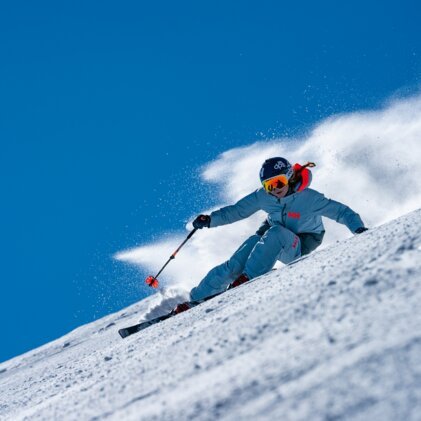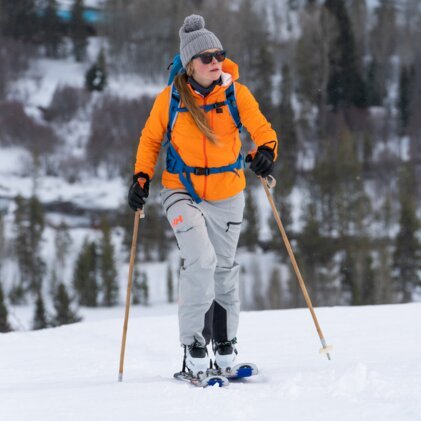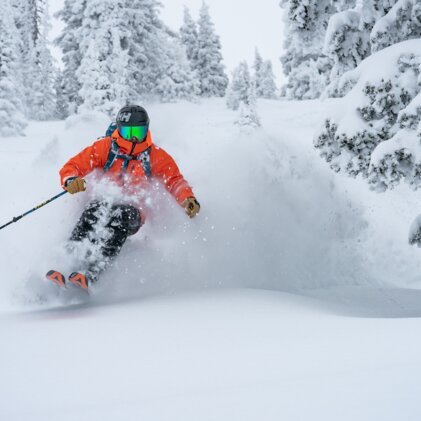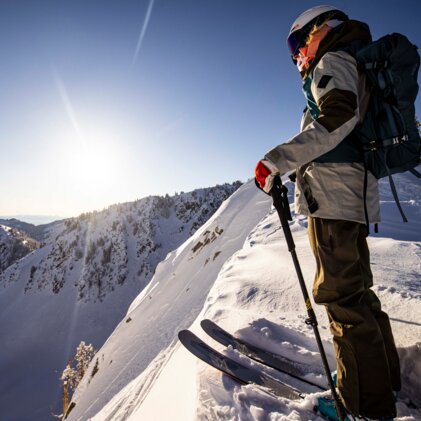All about freeride jackets, trousers & more – with INTERSPORT Rent
*Advertisement
Staying comfortable and dry in deep powder only works with the right freeride clothing. After all, your jacket and trousers need to be able to handle the rugged conditions of the backcountry. The most important prerequisite: Your outfit needs to be waterproof.
As the perfect outfit starts with your underwear, every layer of your clothing should be chosen carefully. The more boxes your freeride clothes tick, the more you will be able to enjoy your backcountry adventures. So it makes sense to read up on what’s important before buying a new freeride outfit.
What should you keep in mind when buying freeride clothing? In this article, we have listed the most important facts for your next backcountry trip!
What types of freeride jackets are there?
Basically, you can choose between two types of freeride jackets:
Either – or? Of course, you can also wear them on top of each other. If you get too hot, simply remove the insulated jacket and put it in your backpack.
Hardshell jackets …
- are very robust, making them ideal for the backcountry.
- combine a waterproof outer shell with a breathable membrane.
- keep you from getting wet.
- don’t have insulating properties but plenty of technical features.
- are lightweight and have a small pack size.
Our tip: Hardshell jackets are often worn in combination with one or more mid layers.
Insulated jackets …
- have an insulated outer shell.
- keep your body heat inside the jacket, preventing you from getting cold.
- are ideal for riding at sub-zero temperatures.
- are particularly lightweight.
- are moderately breathable.
- are usually water-repellent but not waterproof.
- are less suitable for days with great changes in temperature (they quickly become too warm).
Which characteristics should your freeride clothing have?
Good-quality freeride jackets and trousers are water- and windproof, breathable and insulating. The details:
Waterproofness
First of all, your freeride clothing should be waterproof. The waterproofness of your jacket or trousers is indicated by something called the “hydrostatic head”. The higher this measurement unit, the more waterproof the fabric. A hydrostatic head of 10,000 to 20,000 millimetres should keep you reasonably dry.
A Gore-Tex® membrane will also protect you from the wind and snow. Plus, freeride clothing usually consists of two- to three-layer materials, providing you with an additional barrier against the weather. Welded seams and zips also prevent rain and snow from entering the fabric.
Breathability
The breathability of a fabric refers to its ability to allow air to pass through. This way, water vapour (or moisture) can escape to the outside, making it possible for sweat to be wicked to the surface. The result: You stay dry and warm.
However, this job is not only down to your outer shell (third or shell layer) but also to your other layers – your ski underwear (first or base layer) and your mid layer (second layer).
Insulation
Insulation is another word for reduced heat transfer – and it’s especially important in sub-zero temperatures. Insulated jackets with natural or synthetic down are particularly warm. You can also wear several layers on top of each other to keep warm during freeriding.
Our tip: For even more information about dressing in layers, scroll further down the page.
What are the most important features of freeride jackets and trousers?
Powder shreds come with a considerable amount of spraying snow. And when you take a fall, you’ll be especially glad to wear high-quality freeride clothing. The following features are useful to keep powder snow from getting into your freeride jacket and trousers:
- an extra snow guard
- adjustable straps
- wrist guards with a thumb loop
- sleeves with Velcro fasteners
- elastic inner collar
- adjustable hood
- pit zips and other zippered openings (to allow moisture to escape)
- detachable bib / kidney protection
- adjustable leg cuffs (or gaiters)
- (plenty of) inside pockets and sealed outside pockets for your smartphone, ski pass, goggle cleaning cloth etc.
What else should you keep in mind when buying freeride clothing?
Safety takes on a different dimension once you leave the groomed slopes. After all, backcountry trips come with the risk of avalanches. In addition to professional avalanche safety equipment, you can also contribute to your safety in the mountains with your freeride clothing. For instance, by wearing freeride jackets and trousers with a Recco® system, which helps rescuers to find avalanche victims.
Layering: how dressing in layers works
Once you have mastered the secret of dressing in layers, you will never be cold or sweaty during freeriding again. Basically, every outfit consists of three layers: your underwear, a fleece or shirt, and a freeride jacket and trousers on top.
Sounds easy enough – but it’s all about the properties and qualities of the individual layers. After all, the goals of dressing in layers are optimum air circulation and moisture management – the most important prerequisites for truly enjoyable powder adventures.
The individual layers and their tasks at a glance
- Base layer: Functional underwear or ski underwear wicks sweat away from your skin and therefore has to be close-fitting. Frequently used materials: merino wool and polyester.
- Mid layer: This layer retains your body heat and keeps out moisture. It can consist of several clothing items, e.g. a long-sleeve top made of wool or a fleece.
- Shell layer: a breathable, robust outer shell consisting of a freeride jacket and freeride trousers. It protects you from the wind and weather. Frequently used technologies: Gore-Tex®, PrimaLoft® and SympaTex.
Which other clothing items and accessories do you need for freeriding?
- gloves
- a hat that fits under your helmet or a balaclava
- ski goggles that are compatible with your helmet
- ski socks as part of your ski underwear
- a back protector to protect your spine during falls
Get the facts, test the products, buy your favourites!
Now that you know everything about freeride clothing, it’s time for some product testing! At INTERSPORT Rent, you can test top-class freeride equipment before spending money on products you have never actually tried in the powder.
















